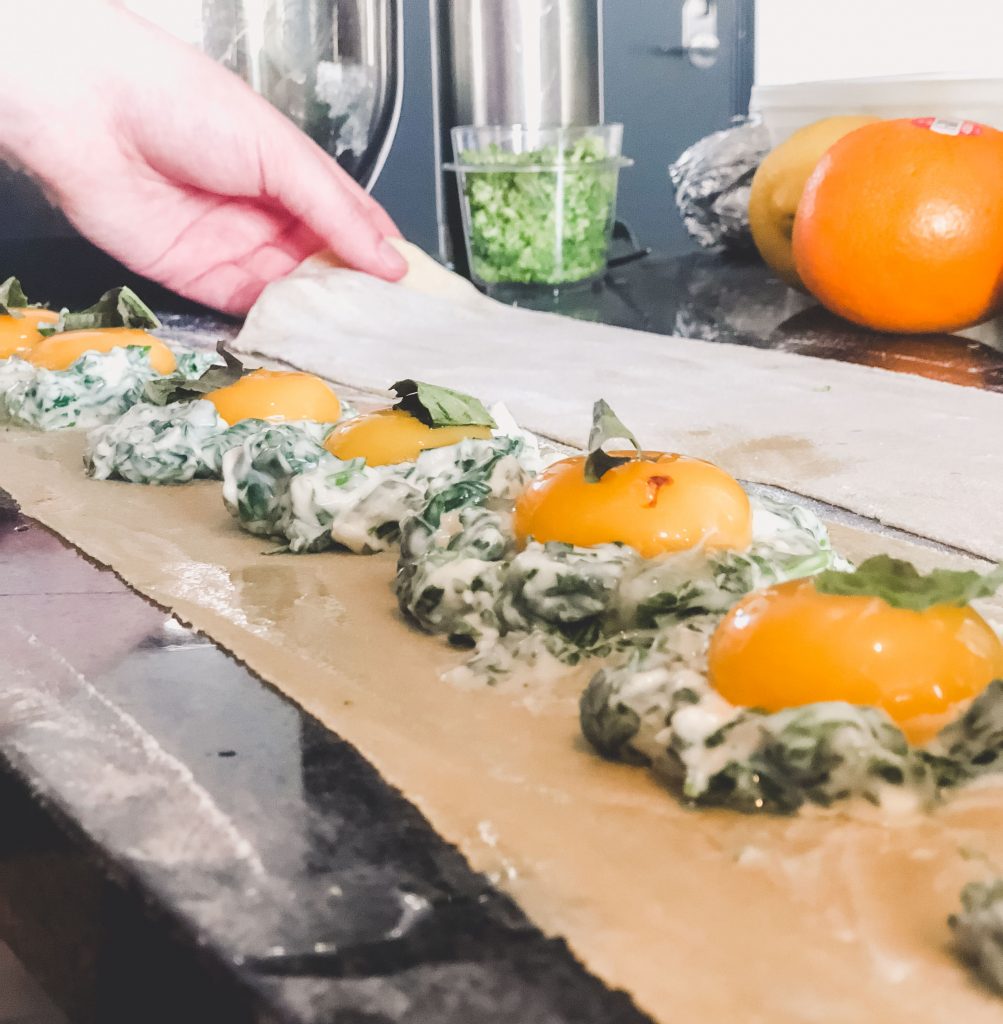
— all images courtesy of Mitch Fagan
 Four people stood in the apartment on the sixth floor of the Lark at Kohl building in Madison, nervously looking at their phones, checking the time every minute. Mitch Fagan, 22, the chef for the evening, was running around in the kitchen preparing the food. Everything was set — the only thing missing were the guests.
Four people stood in the apartment on the sixth floor of the Lark at Kohl building in Madison, nervously looking at their phones, checking the time every minute. Mitch Fagan, 22, the chef for the evening, was running around in the kitchen preparing the food. Everything was set — the only thing missing were the guests.
It was now 15 minutes past the supposed beginning of the event, and the people in the room were starting to wonder, “What if no one comes?” Wynn Culver, 23, and Jacob Moore, 22, couldn’t help but worry if Fagan’s all-day efforts would go to waste, and neither could I. This day had been planned for approximately two weeks, but we had left the recruitment part (the most important part in our plan) for the last moment, and although we had some tentative promises of attendance, nothing was set in stone.
The four of us stood still, staring at the front door.
What we were attempting to accomplish that night was to invite eight complete strangers to our apartment and feed them an eight-course meal — and we weren’t at all sure we could pull it off.
Getting out of your comfort zone isn’t easy, but it is important to push the boundaries of what you are used to and not limit yourself to the basics of your daily routine. Science explains why it’s hard to break your routine and why you should do it. Fear of the unknown shouldn’t stop you from having new experiences. But humans tend to get comfortable and familiar with our routines, and although something new thrown in there can be frightening at first, psychology says that it can be healthy, and often the benefits outweigh the risks.
Fagan, Culver and I were watching a YouTube channel called Yes Theory, a place for videos by creators who travel the world getting out of their comfort zones and setting challenges for themselves and for strangers. While watching these videos, an idea began to form. The Yes Theory people were creating a restaurant for a night, inviting strangers off the street to dine for free. Their goal was simple: Become the No. 1 reviewed restaurant in Los Angeles for the night.
As the video ended, we decided to recreate this in Madison and came up with a plan. Fagan, now a medical student in Kansas City, Missouri, has a passion for cooking and immediately jumped at the idea of being the chef, while Culver and I would be the waiters and recruit people. All we could talk about in the coming weeks, unfortunately, wasn’t our studies, but the pop-up restaurant.

The comfort zone is a psychological space where you feel at ease and in control of your environment because it involves a familiar routine. It provides humans with a state of mental security, where we experience low anxiety and stress, and we can have a steady level of performance that keeps us happy.
The comfort zone dates back to a classic psychology experiment. Psychologists Robert Yerkes and John Dodson showed that relative comfort leads to a steady level of performance. However, to maximize performance, we need a relative state of anxiety — our stress levels need to be higher than normal.
“If arousal is really low, it probably means you’re bored, and you’re probably not going to perform really well,” says Shawn Green, an associate professor of psychology at UW-Madison. “If your arousal becomes too high it probably means that you have a challenge that you think you cannot meet, performance is low and there’s a host of issues.”
We perform best when we are faced with “optimal anxiety,” which lies just outside of our comfort zone. This idea isn’t new, and everyone who has tried to accomplish something, no matter how small, knows that when you challenge yourself, there can be great results. A lot of studies support this, but biting off more than you can chew can actually have a negative result.
One thing you should avoid is overstressing, says Robert McGrath, distinguished psychologist emeritus at University Health Services at UW-Madison.
“You want to reduce unnecessary stress, self-imposed stress, but you want to have stress in your life,” McGrath says.
We need it for performance, but it can also help our immune system work at a higher level. Small amounts of stress are good, but when the levels are high for a long time, the effects it has on our minds and bodies is crippling.
Chris Coe, a professor in the psychology department at UW-Madison, researches the biology of brain and behavior. In an email, he explained that the first thing that happens to our minds in a stressful situation is an evaluation process based on our prior experiences and memory — psychologists call it “primary appraisal.” This means that the hippocampus, the part of the brain associated with memory, activates, and our memories are searched for ways to deal with the stress. Following this, the amygdala, an area of the brain that is involved in emotional processing, will be engaged. Both of these are part of the larger circuitry called the limbic system, which governs emotion and communicates with the forebrain areas.
According to ThoughtCo, an educational website, this is the part of the brain that receives and processes information, and is responsible for “thinking, perceiving, producing and understanding language, and controlling motor function.” The insula cortex, which helps our brain process negative experiences and is important in determining the degree of pain we feel, is also activated, and it isn’t a surprise that stress can feel painful.
“It is not a surprise that there is often an association between pain and depression, especially in the case of a person dealing with a chronic pain condition like fibromyalgia or arthritis,” Coe added in the email.
That is how I felt in the early afternoon on the day of the pop-up restaurant. Culver and I went to the Memorial Union Terrace in the hopes of finding people adventurous enough to come to our apartment at 7 p.m. the same day. Talking to complete strangers — and asking them a very peculiar question — was scary, stressful and anxiety inducing.

The first people we talked to weren’t remotely interested in dining for free — our main selling point. The Terrace was a bust, and we took our disappearing confidence in finding people with us toward State Street. Although we felt a bit discouraged at the rejections we kept on receiving, I felt my confidence in approaching and talking to strangers increase. The first time I asked someone I felt like my voice was quivering, and I was uncomfortable. By the eighth time, it was much easier.
Culver was uncomfortable for a different reason. He is an extroverted person and loves talking to people no matter the circumstances, and he believes that helped in the recruitment process. But the prospect of pulling people off the streets without any prior knowledge of who they were and having them over to his apartment, which housed everything he owned, was scary.
“The fear that people might break something, ruin something or even steal something absolutely was there,” Culver says.
When getting out of your comfort zone, Green recommends taking it in baby steps. Humans are “built to learn from error signals,” meaning we learn from trial and error. Green says that according to learning theory, the best way for us to learn is by being kept just outside of our ability level so we’re still making some tractable mistakes.
“Taking a seventh grader [who’s] never done any advanced math and plopping them in college calculus, that’s probably too far,” Green says. “Basically none of the error signals that they make will be useful.”
Both Green and McGrath agree that the stress from getting out of your comfort zone needs to be conquered in a way that slowly builds up your resistance — a process called systematic desensitization. For example, a person who has a fear of public speaking would overcome it slowly by building tolerance.
“A therapist would never just jam them in front of an audience,” Green says. “You would take these small steps … it’s like, ‘OK, let’s go and talk in front of three people that I know. Then once I’m comfortable talking in front of three people I know, maybe I’ll talk in front of eight people that I know, and then maybe I’ll add in some strangers.’”

After spending four hours recruiting people, Culver and I made our way back to the apartment. We had had some success, but it wasn’t a sure thing. We decided to also ask people who lived in the building, and some said they might come.
As I entered our restaurant after going to my place to change, the air seemed to not move. The tension and nervousness when the clock struck 7 p.m. was obvious. Time moved slowly, and every time I looked at my phone, my thoughts wandered to the possibility of this whole thing being a bust. We waited.
Unlike me, Culver says he would have been a lot more nervous if he was alone.
“The fact that this entire thing was pulled together through the work of many people I felt that the burden was also being shared by those same people,” Culver says.
At 7:20 p.m., as we were about to give up, there came a knock at the door. We opened it to see some people nervously waiting, worried about what they had gotten themselves into. We invited them in, poured them wine, and then another knock came. More people. In the next 15 minutes, all the chairs were filled with people who didn’t know each other. The silence had been taken over by conversations as they got to know each other.
The night would continue at a joyous pace that made me proud of what we had done. Trying new things shouldn’t be a massive leap that will deter you from ever taking the risk again. Baby steps — and maybe the help of friends and family — can help you accomplish things you never thought you could. Your comfort zone isn’t a bad thing, but if you want to grow, you need to step out of it from time to time.
“At the very end of the night it was like these people had known each other a lot longer than just a couple hours, and even the waiters and the chef had joined in on the bonding,” Culver says. “I like to think that it helped create a whole new network for everyone involved as well as a memory that everyone would be able to look back at and think of as a truly special night.”

Teodor, copy editor, is a second-year professional master’s journalism student in the School of Journalism and Mass Communication. Upon graduation, Teodor will pursue a career as an investigative journalist.